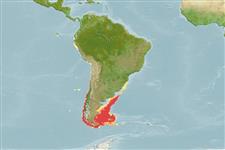>
Perciformes/Notothenioidei (Icefishes) >
Nototheniidae (Cod icefishes) > Nototheniinae
Etymology: Patagonotothen: Composed from Patagonia, the Argentinian province + Greek,noton = back + Greek, adverbial particle, then, that denotes distance or removal (Ref. 45335).
More on author: Richardson.
Environment: milieu / climate zone / depth range / distribution range
นิเวศวิทยา
เกี่ยวกับทะเล,น้ำเค็ม กลุ่มสัตว์หน้าดิน,กลุ่มสัตว์พื้นท้องน้ำ. Subtropical
Southeast Pacific and Southwest Atlantic: Chilean and Argentine Patagonia.
ขนาด / น้ำหนัก / Age
Maturity: Lm ? range ? - ? cm
Max length : 28.0 cm TL เพศผู้/กระเทย; (Ref. 56972); น้ำหนักสูงสุดที่มีการรายงาน: 311.00 g (Ref. 124534)
Short description
เครื่องมือที่ใช้ในการแยกชนิดสัตว์,สิ่งมีชีวิตออกจากกัน | สัณฐานวิทยา | ความยาวต่างๆ
เงี่ยงครีบหลัง (รวม) : 5; ก้านครีบอ่อนที่หาง (รวม) : 32; เงี่ยงครีบก้น: 0; ก้านครีบอ่อนที่ก้น: 30. Scale on lateral line 43 (upper), 8 (lower). Caudal fin subtruncate. Body brownish above and paler below, with irregular broad dark blotches on body. First dorsal fin with a black spot covering greater part of it. First dorsal and caudal fins variegated with series of small dark spots (Ref. 27363).
Males guard the nesting sites (Ref. 57915).
Life cycle and mating behavior
Maturities | การสืบพันธุ์ | Spawnings | Egg(s) | Fecundities | ตัวอ่อน
Male parental care (Ref. 57915).
Hureau, J.-C., 1985. Nototheniidae. p. 323-385. In W. Fischer and J.C. Hureau (eds.) FAO species identification sheets for fishery purposes. Southern Ocean (Fishing areas 48, 58 and 88). Rome. Vol. 2:233-470. (Ref. 2807)
IUCN Red List Status (Ref. 130435)
Threat to humans
Harmless
Human uses
เครื่องมือ
Special reports
Download XML
แหล่งที่มาจากอินเตอร์เน็ต
Estimates based on models
Preferred temperature (Ref.
123201): 4.7 - 9.7, mean 6.1 °C (based on 210 cells).
Phylogenetic diversity index (Ref.
82804): PD
50 = 0.5001 [Uniqueness, from 0.5 = low to 2.0 = high].
Bayesian length-weight: a=0.00631 (0.00372 - 0.01070), b=3.23 (3.08 - 3.38), in cm total length, based on LWR estimates for this species & (Sub)family-body (Ref.
93245).
ระดับชั้นอาหาร (Ref.
69278): 3.8 ±0.6 se; based on size and trophs of closest relatives
ความสามารถในการกลับคืนสู่ปกติ (Ref.
120179): ขนาดกลาง, เวลาต่ำสุดที่จะทำให้ประชากรเพิ่มขึ้นเป็น 2 เท่าใช้เวลา 1.4 - 4.4 ปี (Fec = 7,634).
Fishing Vulnerability (Ref.
59153): Low vulnerability (18 of 100).
Nutrients (Ref.
124155): Calcium = 67.8 [42.8, 123.6] mg/100g; Iron = 0.955 [0.625, 1.543] mg/100g; Protein = 17.8 [16.5, 19.2] %; Omega3 = 0.382 [0.230, 0.607] g/100g; Selenium = 29.4 [15.4, 57.0] μg/100g; VitaminA = 39 [14, 114] μg/100g; Zinc = 0.91 [0.67, 1.23] mg/100g (wet weight);
